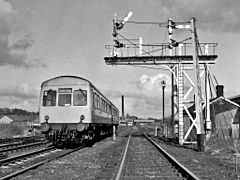British Rail Class 111 facts for kids
Quick facts for kids British Rail Class 111 |
|
|---|---|
 |
|
| In service | 1957- |
| Manufacturer | Metropolitan Cammell |
| Number built | 23 trainset |
| Formation | Unknown |
| Operator(s) | British Rail |
| Specifications | |
| Car length | 57 ft (17.37 m) |
| Width | 9 ft 3 in (2.81 m) |
| Height | 3.77 m |
| Maximum speed | 70 mph (112 km/h) |
| Weight | 33 tons |
| Prime mover(s) | Rolls-Royce, 180 hp |
The British Rail Class 111 was a special type of diesel train. These trains were built in the United Kingdom. They were designed to carry passengers. They started running in 1957.
Contents
What is a Class 111 Train?
The Class 111 trains were called Diesel Multiple Units, or DMUs. This means they were powered by diesel engines. They could run on their own, without a separate locomotive.
How Did They Look?
These trains looked a lot like another popular train, the Class 101/2s. But the Class 111 had different engines inside. Some of the later Class 111 trains had a special box above the front windows. This box showed a four-character code. It helped railway staff know which train it was and where it was going. The destination sign was also placed above a smaller middle window.
Who Built These Trains?
The Class 111 trains were made by a company called Metropolitan Cammell. This company built many trains for British Rail. The Class 111 was part of a larger order for 339 trains from Met-Camm.
When Were They Built?
The first Class 111 trains were built in early 1957. These first trains were made up of four cars. They were used in the Manchester area. One of these first trains had a more powerful engine. It had a supercharged 230 horsepower engine.
Where Did They Run?
After the first trains, more Class 111 sets were built. Ten sets, each with three cars, were made for the Eastern Region of British Railways. These trains ran in the Bradford area. Later, twenty more three-car sets were built.

